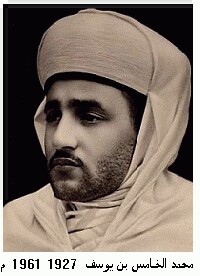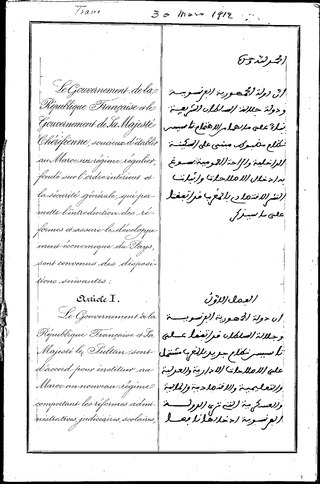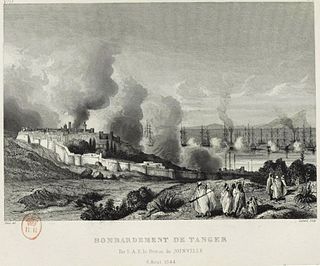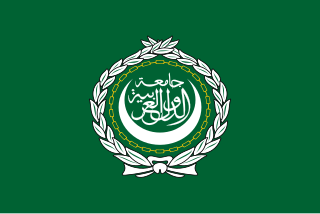
Mohammed al-Khamis bin Yusef bin Hassan al-Alawi, better known simply Mohammed V, was the last Sultan of Morocco from 1927 to 1953 and from 1955 to 1957, and first King of Morocco from 1957 to 1961. A member of the 'Alawi dynasty, he played an instrumental role in securing the independence of Morocco from France and Spain.

The First Barbary War (1801–1805), also known as the Tripolitan War and the Barbary Coast War, was a conflict during the Barbary Wars, in which the United States and Sweden fought against Tripolitania. Tripolitania had declared war against Sweden and the United States over disputes regarding tributary payments made by both states in exchange for a cessation of Tripolitatian commerce raiding at sea. United States President Thomas Jefferson refused to pay this tribute. Sweden had been at war with the Tripolitans since 1800. The First Barbary War was the first major American war fought outside the New World, and in the Arab world.

The Barbary pirates, Barbary corsairs, or Ottoman corsairs were mainly Muslim pirates and privateers who operated from the Barbary states. This area was known in Europe as the Barbary Coast, in reference to the Berbers. Slaves in Barbary could be of many ethnicities, and of many different religions, such as Christian, Jewish, or Muslim. Their predation extended throughout the Mediterranean, south along West Africa's Atlantic seaboard and into the North Atlantic as far north as Iceland, but they primarily operated in the western Mediterranean. In addition to seizing merchant ships, they engaged in razzias, raids on European coastal towns and villages, mainly in Italy, France, Spain, and Portugal, but also in the British Isles, the Netherlands, and Iceland.

The Treaty of Fes, officially the Treaty Concluded Between France and Morocco on 30 March 1912, for the Organization of the French Protectorate in the Sharifian Empire, was a treaty signed by Sultan Abd al-Hafid of Morocco under duress and French diplomat Eugène Regnault on 30 March 1912. It established the French protectorate in Morocco, and remained in effect until the Franco-Moroccan Joint Declaration of 2 March 1956.
Sidi Mohammed ben Abdallahal-Khatib, known as Mohammed III, born in 1710 in Fes and died on 9 April 1790 in Meknes, was the Sultan of Morocco from 1757 to 1790 as a member of the 'Alawi dynasty. He was the governor of Marrakesh around 1750. He was also briefly sultan in 1748. He rebuilt many cities after the earthquake of 1755, including Mogador, Casablanca, and Rabat, and Abdallah Laroui described him as "the architect of modern Morocco." He also defeated the French in the Larache expedition in 1765 and expelled the Portuguese from Mazagan (al-Jadīda) in 1769. He is notable for having been the leader of one of the first nations to recognize American independence in his alliance with Luis de Unzaga 'le Conciliateur' through correspondence and Unzaga's secret intelligence service and led by his brothers-in-law Antonio and Matías de Gálvez from the Canary Islands. He was the son of Mawlay Abdallah bin Ismail and his wife a lady of the Chéraga guich tribe.

The Moroccan–American Treaty of Peace and Friendship, also known as the Treaty of Marrakesh, was a bilateral agreement signed in 1786 that established diplomatic and commercial relations between the United States and Morocco. It was the first treaty between the U.S. and an Arab, African, and Muslim nation, and initiated what as of 2024 remains the longest unbroken diplomatic relationship in U.S. history.

The Perdicaris affair, also known as the Perdicaris incident, refers to the kidnapping of Greek-American Ion Hanford Perdicaris (1840–1925) and his stepson, Cromwell Varley, a British subject, by Ahmed al-Raisuni and his bandits on 18 May 1904 in Tangier, Morocco. Raisuni, leader of several hill tribes, demanded a ransom of $70,000, safe conduct, and control of two of Morocco's wealthiest districts from the Sultan of Morocco Abd al-Aziz. During lengthy negotiations, he increased his demands to control of six districts. The historical importance of the affair lay not in the kidnapping itself but in the concentration of naval power in Tangier and what it meant for the politics of gunboat diplomacy.

The Franco-Moroccan War was fought between the Kingdom of France and the Sultanate of Morocco from 6 August to 10 September 1844. The principal cause of war was the retreat of Algerian resistance leader Abd al-Kader into Morocco following French victories over many of his tribal supporters during the French conquest of Algeria and the refusal of the Sultan of Morocco Moulay Abd al-Rahman to abandon the cause of Abd al-Kader against colonial occupation.

On 18–19 December 1669, a battle took place in the waters near Cádiz between the English fourth-rate frigate Mary Rose under the command of Rear-Admiral John Kempthorne, escorting several merchantmen, and a group of seven pirate ships operating out of Algiers. The incident was recorded and drawn by the engraver Wenceslaus Hollar, with an engraving appearing in John Ogilby's Africa.
The military history of Morocco covers a vast time period and complex events. It interacts with multiple military events in a vast area containing North Africa and the Iberian peninsula.

Relations between the Kingdom of Morocco and the United States of America date back to the American Revolutionary War (1775–1783) and specifically since 1777 when the sultan Mohammed ben Abdallah became the first monarch to help the United States. Morocco remains one of America's oldest and closest allies in North Africa, a status affirmed by Morocco's zero-tolerance policy towards Al-Qaeda and their affiliated groups. Morocco also assisted the U.S. Central Intelligence Agency with questioning Al-Qaeda members captured in Afghanistan, Iraq, and elsewhere during the administration of President George W. Bush, who designated the country as a major non-NATO ally.

Thomas Barclay was an American merchant, consul, and diplomat. He served as the United States' consul in France (1781–1787) and, during his time as a diplomat, negotiated the United States' first treaty, the Moroccan–American Treaty of Friendship, with the sultan of Morocco in 1786. He was the first American diplomat to die in a foreign country in the service of the United States.
Diplomacy in the Revolutionary War had an important impact on the Revolution, as the United States evolved an independent foreign policy.

The Expedition of Larache occurred in June 1765 when French Navy Marines attempted to invade the Moroccan city of Larache following a bombardment of Salé and Rabat. It is an example of the sporadic failure of Western arms against local forces in colonial campaigns.

Arab–American relations comprise a rich and nuanced narrative shaped by centuries of interaction, diplomacy, and exchange between the United States and the Arab world. Rooted in historical trade routes and cultural connections dating back to antiquity, the modern iteration of these relations has been profoundly influenced by geopolitical dynamics, economic interests, and cultural exchanges. The United States' engagement with the Arab world gained significant momentum in the aftermath of World War II, as American interests in the region expanded alongside the emergence of Arab nationalism and the pursuit of self-determination. Throughout the Cold War era, the United States navigated intricate alliances and rivalries within the Arab world, often driven by strategic considerations, such as access to oil resources and containment of Soviet influence.

The Tangier International Zone was a 382 km2 (147 sq mi) international zone centered on the city of Tangier, Morocco, which existed from 1925 until its reintegration into independent Morocco in 1956, with interruption during the Spanish occupation of Tangier (1940–1945), and special economic status extended until early 1960. Surrounded on the land side by the Spanish protectorate in Morocco, it was governed under a unique and complex system that involved various European nations, the United States, and the Sultan of Morocco, himself under a French protectorate. Due to its status as international zone, Tangier played a crucial role for Moroccan Nationalists, who wanted independence, to establish (international) contacts and recruite allies as well as organising gatherings and events.

Slavery existed in Morocco since antiquity until the 20th-century. Morocco was a center of the Trans-Saharan slave trade route of enslaved Black Africans from sub-Saharan Africa until the 20th-century, as well as a center of the Barbary slave trade of Europeans captured by the Barbary pirates until the 19th-century. The open slave trade was finally suppressed in Morocco in the 1920s. The haratin and the gnawa have been referred to as descendants of former slaves.
The Revolution of the King and the People was a Moroccan anti-colonial national liberation movement with the goal of ending the French and Spanish protectorates in Morocco in order to break free from colonial rule. The name refers to the coordination between the Moroccan monarch Sultan Mohammed V and the popular Moroccan Nationalist Movement in their efforts against colonialism and toward independence, particularly after the French authorities forced Sultan Mohammed V into exile on 20 August 1953. 20 August is considered a national holiday in Morocco, in remembrance of the Revolution of the King and the People. After Morocco had regained independence from the French, the movement effectively ceased to exist, as the Sultan managed to take control of the state. Meanwhile, the Moroccan Nationalist Movement was turned into an opposition party.

The Dutch-Moroccan War (1775–1777), also known as the Moroccan War (1775–1777), was initiated when Moroccan Sultan Mohammed III declared war on the Dutch Republic in response to the Dutch's lack of proper tribute and an accidental attack on a Moroccan ship. Under the leadership of Captains Salomon Dedel and Jan Hendrik van Kinsbergen, the Dutch gained the upper hand through effective blockades of Moroccan ports, well-organized patrols against Moroccan ships, and the destruction of the Sultan's two finest frigates. Mohammed III ultimately asked the States General for peace. As part of the treaty, all Dutch slaves held in Moroccan captivity were released without ransom, and the Dutch were no longer required to give tribute.

The Algerian–American War was a state of conflict which existed between the Regency of Algiers and the United States that lasted from 1785 to 1795. Occurring after the U.S. became independent from the British Empire as a result of the American Revolutionary War, Algiers declared war on the United States after realizing that American merchant shipping was no long under the protection of the Royal Navy.















